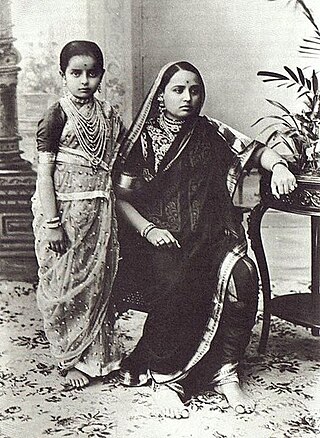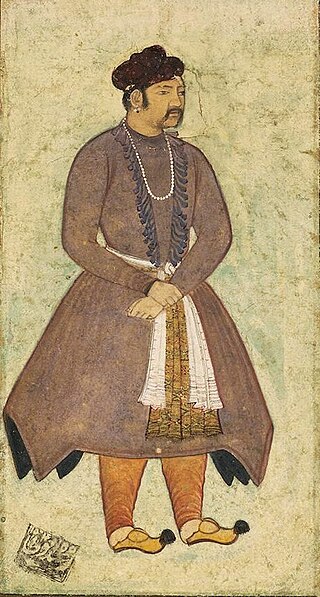Related Research Articles

A sari is a women's garment from the Indian subcontinent. It consists of an un-stitched stretch of woven fabric arranged over the body as a robe, with one end attached to the waist, while the other end rests over one shoulder as a stole (shawl), sometimes baring a part of the midriff. It may vary from 4.1 to 8.2 metres in length, and 60 to 120 centimetres in breadth, and is a form of ethnic wear in India, Sri Lanka, Nepal, Bangladesh, Pakistan. There are various names and styles of sari manufacture and draping, the most common being the Nivi style. The sari is worn with a fitted bodice also called a choli and a petticoat called ghagra, parkar, or ul-pavadai. It remains fashionable in the Indian subcontinent today.

A kurta is a loose collarless shirt or tunic worn in many regions of South Asia, and now also worn around the world. Tracing its roots to Central Asian nomadic tunics, or upper body garments, of the late-ancient- or early-medieval era, the kurta has evolved stylistically over the centuries, especially in South Asia, as a garment for everyday wear as well as for formal occasions.

The dhoti, also known as veshti, mardani, dhotar, jaiñboh, or panchey, is a piece of cloth arranged around the legs to resemble trousers. It is most popular in India and Nepal. The dhoti is a lower garment forming part of ethnic wear for men in the Indian subcontinent. The dhoti is fashioned out of a rectangular piece of unstitched cloth, usually around 4.5 metres (15 ft) long, wrapped around the waist and the legs and usually knotted in the front.
Clothing in India varies with the different ethnicities, geography, climate, and cultural traditions of the people of each region of India. Historically, clothing has evolved from simple garments like kaupina, langota, achkan, lungi, sari, to rituals and dance performances. In urban areas, western clothing is common and uniformly worn by people of all social levels. India also has a great diversity in terms of weaves, fibers, colors, and the material of clothing. Sometimes, color codes are followed in clothing based on the religion and ritual concerned. The clothing in India also encompasses a wide variety of Indian embroidery, prints, handwork, embellishments, and styles of wearing clothes. A wide mix of Indian traditional clothing and western styles can be seen in India.

The lungi is a clothing similar to the sarong that originated in the Indian subcontinent. The lungi, which usually multicoloured, is a men's skirt usually tied around the lower waist below the navel. It can be worn as casual wear and night wear. It is favoured in hot and humid climates where the airflow it allows makes it more comfortable than alternatives.

Sherwani is a long-sleeved outer coat worn by men in South Asia. Like the Western frock coat, it is fitted, with some waist suppression; it falls to below the knees and is buttoned down the front. It can be collarless, have a shirt-style collar, or a stand-up collar in the style of the Mandarin collar. It evolved in the Indian subcontinent in the 19th-century as a result of the outer garment of the late Mughal period, the angarkha—itself evolved from the Persian cape, balaba—being given a western style with a button-down front.

Ghagra choli is a type of ethnic clothing for women from the Indian Subcontinent, notably in the Indian states of Rajasthan, Gujarat, Madhya Pradesh, Uttar Pradesh, Bihar, Haryana, Punjab, Himachal Pradesh, Uttarakhand, Jammu and Kashmir, as well as in the Pakistani provinces of Punjab and Sindh. In Punjab, the lehenga is traditionally worn with a kurti. It is a combination of the gagra or lehenga and the choli (blouse), however in contemporary and modern usage lehenga choli is the more popular and widely accepted term by fashion designers, trend setters, and boutiques in South Asia, since ghagra is synonymous with the half-slip (petticoat) worn as an undergarment below the sari.

Shalwar kameez is a traditional combination dress worn by men and women in South Asia, and Central Asia. Although shalwar kameez is considered a dress of mughal persian which became tradtional in pakistan and north india, a similar dress called suthan in northern india was already traditional.

The Punjabi ghagra is a four-piece outfit known as tewar or 'ti-or' which was traditionally worn by Punjabi women throughout the Punjab region with the outfit comprising a head scarf (Phulkari), kurta or kurti, ghagra and either a suthan or the Punjabi salwar (trousers). In modern times, the ghagra is worn by women in parts of Haryana, rural parts of south West Punjab, parts of Himachal Pradesh and during performances of Giddha in East Punjab.

Salwar or Shalwar is cloth worn from the waist to the ankles, covering both legs separately. It is the lower-garment of the Shalwar kameez suit which is widely-worn in South Asia. It is known for its lively hues, rich fabrics, and embroidery. It is also the national dress of Pakistan, and since the later 1960s with the salwar being used in government offices in Pakistan. The outfit has been a part of Punjabi tradition for centuries. Salwar can be distinguished from the Punjabi suthan which is shorter than the salwar.

Punjabi Kurta and Tamba are traditional costume for men of Punjab.

In the ancient Punjab region, people wore cotton clothing. Both men and women wore knee-length tops. A scarf was worn over the tops which would be draped over the left shoulder and under the right. A large sheet would be further draped over one shoulder which would hang loose towards the knees. Both male and female wore a dhoti around the waist. Modern Punjabi dress has retained this outfit but over its long history has added other forms of dress.

Sindhi clothing are a part of the Sindhi culture. Sindhi women and men wear the Shalwar Qameez or the Kurta with Pyjama. Women also wear Sari or ghagra. However, before the adoption of the Shalwar kameez, kurta, the Sari as well as other articles of clothing, Sindhis had their own traditional costumes.

History of clothing in the Indian subcontinent can be traced to the Indus Valley civilization or earlier. Indians have mainly worn clothing made up of locally grown cotton. India was one of the first places where cotton was cultivated and used even as early as 2500 BCE during the Harappan era. The remnants of the ancient Indian clothing can be found in the figurines discovered from the sites near the Indus Valley civilisation, the rock-cut sculptures, the cave paintings, and human art forms found in temples and monuments. These scriptures view the figures of human wearing clothes which can be wrapped around the body. Taking the instances of the sari to that of turban and the dhoti, the traditional Indian wears were mostly tied around the body in various ways.

Mughal clothing refers to clothing worn by the Mughals in the 16th, 17th and 18th centuries throughout the extent of their empire. Much of them were already being used in the past centuries before their arrival in Indian subcontinent. It was characterized by luxurious styles and was made with muslin, silk, velvet and brocade. Elaborate patterns including dots, checks, and waves were used with colors from various dyes including cochineal, sulfate of iron, sulfate of copper, and sulfate of antimony were used.

The term jama refers to a long coat which was popular in South Asia during the early modern era.
Kurti top is an upper garment worn in the Indian subcontinent encompassing waistcoats, jackets and blouses.

Katzeb was an article of dress encircling the body, at the waist with ends hanging in the front. It was a kind of sash also called patka.
Peshwaj was a ladies outfit similar to a gown or jama coat with front open, tied around the waist, having full sleeves, and the length was full neck to heels. Peshwaj was one of the magnificent costumes of the mughal court ladies. The material was used to be sheer and fine muslins with decorated borders of zari and lacework.
Yalek was an underslip, a ladies garment older than 500 years of the Indian subcontinent. Yalek was a long vest type undergarment, sticking to the body, and the length was down to ankles. The ladies wore Yalek underneath the gowns and other costumes. Both Hindus and the Muslim ladies wore similar dresses except few changes.
References
- ↑ Dhir, V. P.; Bajaj, B. Raj (1976). Haryana district gazetteers: Karnal. Haryana Gazetteers Organisation, Chandigarh. p. 92.
- ↑ Penzer, N. m (1924). Ocean Of Story Vol.2. Motilal Banarsidass. p. 50.
- 1 2 A. BISWAS. INDIAN COSTUMES. pp. 127, 42.
- 1 2 The Edinburgh Review. A. and C. Black. 1867. p. 69.
- ↑ Jukes, Andrew John (1900). Dictionary of the Jatki or Western Panjábi language. Religious Bk. & Tract Soc. p. 22.
- ↑ Buchanan, Francis (1928). Account of the district of Purnea in 1809-10. p. 138.
- ↑ Umair Mirza (1990-01-01). Historical Documents Of Eastern India. p. 104.
- ↑ Watson, John Forbes (1867). The Textile Manufactures and the Costumes of the People of India. Allen. p. 58.
- ↑ Pradesh (India), Madhya (1971). Madhya Pradesh: Betul. Supplement. Government Central Press. p. 105.
- ↑ The Asiatic Journal and Monthly Register for British and Foreign India, China, and Australia. Parbury, Allen, and Company. 1839. p. 251.
- ↑ Punjab District and State Gazetteers: Part A. Compiled and published under the authority of the Punjab government. 1900. p. 87.
- ↑ Dalrymple, William (2003). White Mughals : love and betrayal in eighteenth-century India. Internet Archive. New York : Viking. p. 397. ISBN 978-0-670-03184-9.
- ↑ "BBC Four – Love and Betrayal in India: The White Mughal – A love story that broke the conventional boundaries of Empire". BBC. Retrieved 2022-01-12.
A painting of General William Palmer and his Mughal wife Fyze Baksh, by Johann Zoffany.